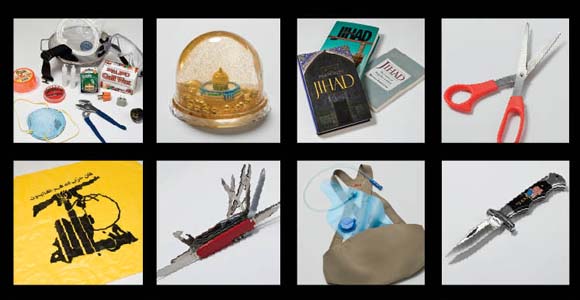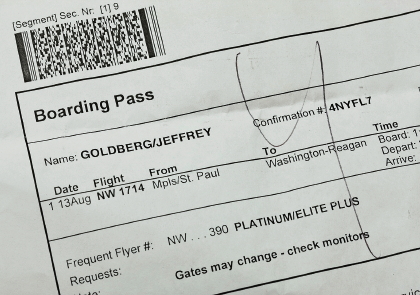|
November 2008 from TheAtlantic Website
If I were a terrorist, and I’m not, but if I were a terrorist—a frosty, tough-like-Chuck-Norris terrorist, say a C-title jihadist with Hezbollah or, more likely, a donkey-work operative with the Judean People’s Front—I would not do what I did in the bathroom of the Minneapolis–St. Paul International Airport, which was to place myself in front of a sink in open view of the male American flying public and ostentatiously rip up a sheaf of counterfeit boarding passes that had been created for me by a frenetic and acerbic security expert named Bruce Schneier.
He had made these boarding passes in his
sophisticated underground forgery works, which consists of a Sony Vaio
laptop and an HP LaserJet printer, in order to prove that the Transportation
Security Administration, which is meant to protect American aviation from
al-Qaeda, represents an egregious waste of tax dollars,
dollars that could otherwise be used to catch terrorists before they arrive
at the Minneapolis–St. Paul International Airport, by which time it is,
generally speaking, too late.
No one did, thus thwarting, yet again, my plans to get arrested, or at least be the recipient of a thorough sweating by the FBI, for dubious behavior in a large American airport. Suspicious that the measures put in place after the attacks of September 11 to prevent further such attacks are almost entirely for show—security theater is the term of art—I have for some time now been testing, in modest ways, their effectiveness.
Because the TSA’s security regimen seems to be mainly thing-based—most of its 44,500 airport officers are assigned to truffle through carry-on bags for things like guns, bombs, three-ounce tubes of anthrax, Crest toothpaste, nail clippers, Snapple, and so on—I focused my efforts on bringing bad things through security in many different airports, primarily my home airport, Washington’s Reagan National, the one situated approximately 17 feet from the Pentagon, but also in Los Angeles, New York, Miami, Chicago, and at the Wilkes-Barre/Scranton International Airport (which is where I came closest to arousing at least a modest level of suspicion, receiving a symbolic pat-down—all frisks that avoid the sensitive regions are by definition symbolic—and one question about the presence of a Leatherman Multi-Tool in my pocket; said Leatherman was confiscated and is now, I hope, living with the loving family of a TSA employee).
And because I have a fair amount of experience reporting on terrorists, and because terrorist groups produce large quantities of branded knickknacks, I’ve amassed an inspiring collection of al-Qaeda T-shirts, Islamic Jihad flags, Hezbollah videotapes, and inflatable Yasir Arafat dolls (really).
All these things I’ve carried with me through airports across the country.
I’ve also carried, at various times: pocketknives, matches from hotels in Beirut and Peshawar, dust masks, lengths of rope, cigarette lighters, nail clippers, eight-ounce tubes of toothpaste (in my front pocket), bottles of Fiji Water (which is foreign), and, of course, box cutters. I was selected for secondary screening four times—out of dozens of passages through security checkpoints—during this extended experiment.
At one screening, I was relieved of a pair of
nail clippers; during another, a can of shaving cream.
(The company that manufactures the Beerbelly also makes something called a “Winerack,” a bra that holds up to 25 ounces of booze and is recommended, according to the company’s Web site, for PTA meetings.)
My Beerbelly, which fit comfortably over
my beer belly, contained two cans’ worth of Bud Light at the time of the
inspection. It went undetected. The eight-ounce bottle of water in my
carry-on bag, however, was seized by the federal government.
The flag features, as its charming main image, an upraised fist clutching an AK-47 automatic rifle. Atop the rifle is a line of Arabic writing that reads Then surely the party of God are they who will be triumphant. The officer took the flag and spread it out on the inspection table. She finished her inspection, gave me back my flag, and told me I could go.
I said,
The author's forged boarding pass—complete with
Platinum/Elite Plus status
and magical TSA-approval squiggle—got him through security. In Minneapolis, I littered my carry-on with many of my prohibited items, and also an Osama bin Laden, Hero of Islam T-shirt, which often gets a rise out of people who see it.
This day, however, would feature a different sort of experiment, designed to prove not only that the TSA often cannot find anything on you or in your carry-on, but that it has no actual idea who you are, despite the government’s effort to build a comprehensive “no-fly” list. A no-fly list would be a good idea if it worked; Bruce Schneier’s homemade boarding passes were about to prove that it doesn’t.
Schneier is the TSA’s most relentless, and effective, critic; the TSA director, Kip Hawley, told me he respects Schneier’s opinions, though Schneier quite clearly makes his life miserable.
A smart terrorist, he says, won’t try to bring a knife aboard a plane, as I had been doing; he’ll make his own, in the airplane bathroom.
Schneier told me the recipe:
As we stood at an airport Starbucks, Schneier spread before me a batch of fabricated boarding passes for Northwest Airlines flight 1714, scheduled to depart at 2:20 p.m. and arrive at Reagan National at 5:47 p.m. He had taken the liberty of upgrading us to first class, and had even granted me “Platinum/Elite Plus” status, which was gracious of him.
This status would allow us to skip the ranks of hoi-polloi flyers and join the expedited line, which is my preference, because those knotty, teeming security lines are the most dangerous places in airports: terrorists could paralyze U.S. aviation merely by detonating a bomb at any security checkpoint, all of which are, of course, entirely unsecured.
(I once asked Michael Chertoff, the
secretary of Homeland Security, about this. “We actually ultimately do have
a vision of trying to move the security checkpoint away from the gate,
deeper into the airport itself, but there’s always going to be some place
that people congregate. So if you’re asking me, is there any way to protect
against a person taking a bomb into a crowded location and blowing it up,
the answer is no.”)
This assumes, of course, that al-Qaeda will target airplanes for hijacking, or target aviation at all.
He believes that the country would be just as safe as it is today if airport security were rolled back to pre-9/11 levels.
Schneier and I joined the line with our ersatz boarding passes.
We handed our boarding passes and IDs to the security officer, who inspected our driver’s licenses through a loupe, one of those magnifying-glass devices jewelers use for minute examinations of fine detail.
This was the moment of maximum peril, not because the boarding passes were flawed, but because the TSA now trains its officers in the science of behavior detection.
The SPOT program—“Screening of Passengers by Observation Techniques”—was based in part on the work of a psychologist who believes that involuntary facial-muscle movements, including the most fleeting “micro-expressions,” can betray lying or criminality. The training program for behavior-detection officers is one week long. Our facial muscles did not cooperate with the SPOT program, apparently, because the officer chicken-scratched onto our boarding passes what might have been his signature, or the number 4, or the letter y.
We took our shoes off and placed our laptops in bins. Schneier took from his bag a 12-ounce container labeled “saline solution.”
They did not check. As we gathered our belongings, Schneier held up the bottle and said to the nearest security officer,
We were in the clear. But what did we prove?
The ID triangle: before a passenger boards a commercial flight, he interacts with his airline or the government three times—when he purchases his ticket; when he passes through airport security; and finally at the gate, when he presents his boarding pass to an airline agent. It is at the first point of contact, when the ticket is purchased, that a passenger’s name is checked against the government’s no-fly list.
It is not checked again, and for this reason, Schneier argued, the process is merely another form of security theater.
It’s easy for a terrorist to check whether the
government has cottoned on to his existence, Schneier said; he simply has
to submit his name online to the new, privately run CLEAR program, which is
meant to fast-pass approved travelers through security. If the terrorist is
rejected, then he knows he’s on the watch list.
What if you don’t know how to steal a credit card?
What if you don’t know how to download a PDF of an actual boarding pass and alter it on a home computer?
I couldn’t believe that what Schneier was saying was true—in the national debate over the no-fly list, it is seldom, if ever, mentioned that the no-fly list doesn’t work.
This called for a visit to TSA headquarters. The headquarters is located in Pentagon City, just outside Washington. Kip Hawley, the man who runs the agency, is a bluff, amiable fellow who is capable of making a TSA joke.
I raised the subject of the ID triangle, hoping to get a cogent explanation.
This is what Hawley said:
Aha! I thought. He’s hiding something from me.
He leaned back in his chair.
Well, what are you doing about it?
In other words, the TSA has no immediate plans to check passengers against the no-fly list at the moment before they board their flight. (Hawley said that boarding passes will eventually be encrypted so the TSA can follow their progress from printer to gate.) Nor does it plan to screen airport employees when they show up for work each day.
Pilots—or people dressed as pilots—are screened, as the public knows, but that’s because they enter the airport through the front door. The employees who drive fuel trucks, and make french fries at McDonald’s, and clean airplane bathrooms (to the extent that they’re cleaned anymore) do not pass through magnetometers when they enter the airport, and their possessions are not searched.
To me this always seemed to be, well, another “vulnerability.”
I asked about the depth of background screening for airport employees. He said, noncommittally,
So there are, in other words, two classes of people in airports: those whose shoes are inspected for explosives, and those whose aren’t. How, I asked, do you explain that to the public in a way that makes sense?
Hawley did say that TSA employees conduct random
ID checks and magnetometer screenings, but he did not say how frequently.
I told the document checker at security that I had lost my identification but was hoping I would still be able to make my flight. He said I’d have to speak to a supervisor. The supervisor arrived; he looked smart, unfortunately.
I was starting to get genuinely nervous, which I hoped would generate incriminating micro-expressions.
He asked me if I had any other identification.
I showed him a credit card with my name on it, a library card, and a health-insurance card.
|


